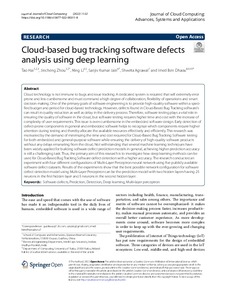Cloud-based bug tracking software defects analysis using deep learning
Hai Tao; Zhou Jincheng; Li Ning; Jain Sanjiv Kumar; Agrawal Shweta; Ben Dhaou Imed
Cloud-based bug tracking software defects analysis using deep learning
Hai Tao
Zhou Jincheng
Li Ning
Jain Sanjiv Kumar
Agrawal Shweta
Ben Dhaou Imed
SPRINGER
Julkaisun pysyvä osoite on:
https://urn.fi/URN:NBN:fi-fe2022102463172
https://urn.fi/URN:NBN:fi-fe2022102463172
Tiivistelmä
Cloud technology is not immune to bugs and issue tracking. A dedicated system is required that will extremely error prone and less cumbersome and must command a high degree of collaboration, flexibility of operations and smart decision making. One of the primary goals of software engineering is to provide high-quality software within a specified budget and period for cloud-based technology. However, defects found in Cloud-Based Bug Tracking software's can result in quality reduction as well as delay in the delivery process. Therefore, software testing plays a vital role in ensuring the quality of software in the cloud, but software testing requires higher time and cost with the increase of complexity of user requirements. This issue is even cumbersome in the embedded software design. Early detection of defect-prone components in general and embedded software helps to recognize which components require higher attention during testing and thereby allocate the available resources effectively and efficiently. This research was motivated by the demand of minimizing the time and cost required for Cloud-Based Bug Tracking Software testing for both embedded and general-purpose software while ensuring the delivery of high-quality software products without any delays emanating from the cloud. Not withstanding that several machine learning techniques have been widely applied for building software defect prediction models in general, achieving higher prediction accuracy is still a challenging task. Thus, the primary aim of this research is to investigate how deep learning methods can be used for Cloud-Based Bug Tracking Software defect detection with a higher accuracy. The research conducted an experiment with four different configurations of Multi-Layer Perceptron neural network using five publicly available software defect datasets. Results of the experiments show that the best possible network configuration for software defect detection model using Multi-Layer Perceptron can be the prediction model with two hidden layers having 25 neurons in the first hidden layer and 5 neurons in the second hidden layer.
Kokoelmat
- Rinnakkaistallenteet [27094]
